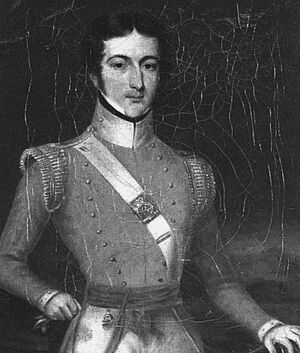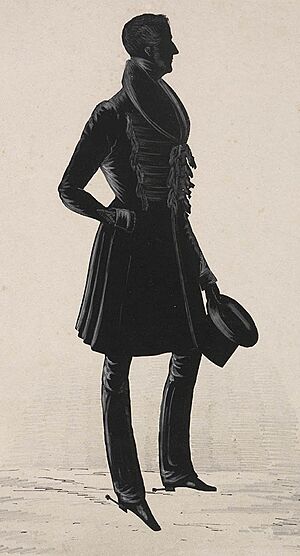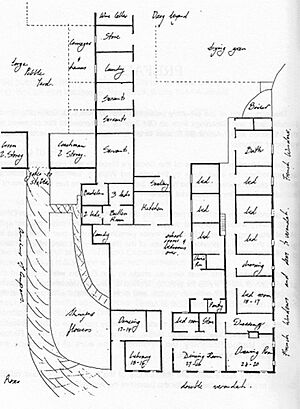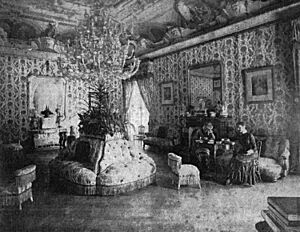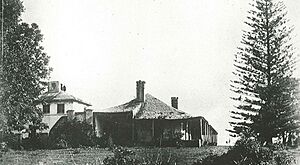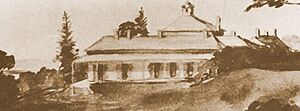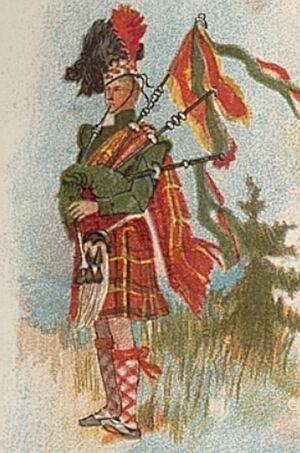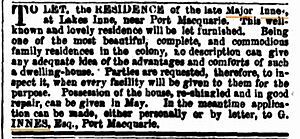Lake Innes House Ruins facts for kids
Quick facts for kids Lake Innes House Ruins |
|
|---|---|

Oil painting of Lake Innes house in 1839 when it was at the peak of its productivity
|
|
| Location | The Ruins Way, Port Macquarie, Port Macquarie-Hastings Council, New South Wales, Australia |
| Built | 1831–1848 |
| Owner | Office of Environment and Heritage |
| Official name: Lake Innes House ruins and environs | |
| Type | state heritage (archaeological-terrestrial) |
| Designated | 2 April 1999 |
| Reference no. | 997 |
| Type | Homestead Complex |
| Category | Farming and Grazing |
| Builders | Major Archibald Clunes Innes |
| Lua error in Module:Location_map at line 420: attempt to index field 'wikibase' (a nil value). | |
The Lake Innes House Ruins are the remains of a large, old house and farm near Port Macquarie, New South Wales, Australia. This special place was once a busy home and farm owned by Major Archibald Clunes Innes. It was built between 1831 and 1848.
Today, the ruins are an interpretive site where you can learn about its past. They include parts of the house, stables, and even a village for workers. You can also see where bricks were made and a boathouse by the lake. The site tells an important story about how New South Wales was settled. It also shows how convicts were used for labor in the 1800s.
The ruins are about 11 kilometers south of Port Macquarie. The NSW National Parks and Wildlife Service looks after them. You can visit this historic site to explore and discover its secrets. It was added to the New South Wales State Heritage Register on April 2, 1999.
Contents
Discovering Lake Innes House History
Major Archibald Innes: The Builder
Archibald Clunes Innes was born in 1800 in Thrumster, Scotland. He joined the army at just 13 years old. He came to Sydney in 1822 on a ship carrying convicts. Later, he worked in Tasmania and helped catch escaped convicts.
In 1825, he became an important assistant to the governor of New South Wales. He also became a magistrate, which is like a judge. After that, he was in charge of the convict settlement at Port Macquarie. In 1829, he married Margaret, whose father was a very important government official.
In 1830, Archibald and Margaret moved to Port Macquarie. He received a large piece of land, about 2,568 acres. He also got contracts to provide food for the many convicts living in the area. Port Macquarie was a major convict settlement at that time.
Over the next ten years, Major Innes slowly built his property. By 1840, his house had 22 rooms. It was known as one of the most luxurious homes in the region. It even had an underground water tank, a bathroom, and hot water, which was very rare back then!
During the 1830s and 1840s, Lake Innes House was a popular place for social gatherings. Major Innes welcomed many important guests. Even the Governor of NSW, Sir Charles Fitzroy, visited in 1847.
Major Innes became very wealthy and bought many sheep and cattle farms. He owned land all over northern New South Wales. The town of Glen Innes was even named after him. He also grew the first sugar in the area and planted many grapevines.
Major Innes believed Port Macquarie would become a big port city. However, the river entrance was too dangerous for many ships. The road to the Tablelands was also very difficult to use. These problems, along with a tough economy in the 1840s, led to his financial difficulties.
Also, convicts stopped being sent to New South Wales. This meant the Port Macquarie Penal Settlement closed. Major Innes lost his food contracts and the cheap labor that convicts provided. In 1853, he left Lake Innes House. He took a job as a gold commissioner and magistrate in other towns. He passed away in Newcastle in 1857.
The Grandeur of Lake Innes House
We know a lot about Lake Innes House from the diaries of two young women. Annabella Boswell, Major Innes's niece, lived there from 1843 to 1848. Louisa Isabella Parker also stayed there between 1848 and 1853.
Annabella wrote that the house had 22 well-furnished rooms. There was also a separate building called the "bachelor's hall" with a sitting room and three bedrooms. She drew a plan of the house, which you can see on the right.
She described a wide double verandah at the front, facing the lake and the sunset. Another verandah ran along the south side. The drawing-room was a large square room with windows opening onto the verandah.
Louisa Parker shared more details about her first visit as a child. She remembered arriving in a carriage pulled by four horses after church. They passed through two white gates and drove along a path with lantana hedges.
She saw an observatory tower among tall pine trees and giant bamboos. The drive led to a beautiful garden with flowers and a pretty summer-house. They entered the house through a verandah into a large hall with pictures.
To the left was the library, full of books. The dining room on the opposite side had a very long table, showing how much hospitality was offered. Three large chandeliers hung from the ceiling. The walls had pictures of historical scenes in fancy frames.
Louisa also remembered seeing statues of famous figures like Lord Nelson. The drawing-room was decorated in a rich style with gold-figured satin chairs. It was a beautiful room with fancy tapestries and large pictures.
A long hallway led to the bedrooms. Mrs. Innes's room was there, and another fine room was used by the Governor and his wife. There was even a "French room" with curtains falling over the bed. At the end of the hall was a bathroom with running water.
Steps led to other rooms, including a schoolroom, a governess's room, and a play-room. From these rooms, you could go up to the observatory for amazing views of the lake.
A door from the hallway led to a brick courtyard. The kitchen, a two-story building, was at the back. Above the kitchen were the butler's rooms. Many other buildings filled the area behind the house.
The "bachelor's hall" was a Gothic-style building with a large clock. It was where the men would go to smoke. The whole property felt like a small village with homes for employees, carriage houses, and stables. There was an orchard with lots of fruit and a vineyard for making wine. Visitors were always coming and going.
The Piper of Lake Innes House
Annabella's diary often mentions Bruce, the piper, who played music for everyone at the house. She once wrote that she loved the sound of the bagpipes in the open air.
The piper was Peter Bruce, who came from Scotland around 1840. His family was famous for playing bagpipes. His father and uncle were well-known pipers. Peter and his brother, John, both excellent pipers, moved to Australia.
Peter played the pipes for guests, but he also worked as a servant. Annabella noted that he helped the butler serve at the table. However, his main job seemed to be farming. He was in charge of growing oats, lucerne, maize, and Indian corn.
In 1844, Peter Bruce married Helen Sanderson, a Scottish maid. Their wedding was held in the drawing-room of Lake Innes House. They had several children while living there. In the early 1850s, they moved to the goldfields at Bathurst and then to Beechworth.
Eventually, they settled in Benalla in Victoria. Peter bought land and became a farmer. He kept playing the bagpipes and was known as "one of the best pipers in the colony."
Convicts at Lake Innes
Most of the servants at Lake Innes House were convicts. Even the two butlers mentioned in the diaries were convicts. Annabella wrote about a butler named Lahey. His wife was the ladies' maid to her aunt, Margaret Innes.
This butler was James Lahey, an Irishman who arrived in Australia in 1838. He had been a soldier but was convicted of a military offense. His wife, Martha, followed him to New South Wales. James was assigned to Major Innes and worked as his butler for years. After he received his pardon, he continued to work for Innes. He later became a hotel owner and then a farmer.
Louisa Parker described another butler, George Wilson. He was a tall Scotsman and a former soldier who fought at the Battle of Waterloo. He wore a butler's uniform and was always helpful. George Wilson was a convict sent to Australia in 1838 for a crime. He was 43 years old and had worked as a soldier and indoor servant.
He was sent to the Port Macquarie Penal Settlement. In 1847, he received his "Ticket Of Leave," which allowed him to work for himself. It was likely then that he started working at Lake Innes. When the Innes family moved to Newcastle in 1853, George went with them. He worked for the family until he was very old. He passed away in Port Macquarie in 1876.
Annabella also mentioned Mrs. Halloran, the wife of another convict servant. She lived in a cottage near the poultry yard. Annabella described her as a "decent, industrious creature" who was happy among the pigs and chickens.
James Halloran was an Irish convict who arrived in Sydney in 1840. He had been convicted of stealing timber. His wife and children were allowed to join him in the colony. The Hallorans had a son at Lake Innes in 1842. James received his pardon in 1846, and the family later moved to Sydney.
Not all convicts were as well-behaved. Richard Young was a former soldier who became a convict in 1834. He was assigned to Major Innes in 1837. Two years later, he ran away and became a famous bushranger known as "Gentleman Dick."
Life After the Innes Family
After Major Archibald Innes died in 1857, his son Gustavus Innes inherited the property. Gustavus became a clergyman and did not live at the house. His mother and sister lived there for two years.
The house was then rented out to several people. Dr. Frederick McKellar lived there from 1860 to 1863. Thomas George Wilson rented it from 1863 to 1867, trying to farm, but it wasn't successful.
Later, Dr. John Cash Nield rented the property. He grew sugar cane, which seemed to do well. In 1871, Gustavus Innes sold the farm to Henry Zions, a tailor from Sydney. Henry rented the estate to Rev. Charles Campbell Kemp, who planted more grapevines.
Rev. Kemp's son, Beilby Kemp, wrote about his stay at Lake Innes around 1872. He described the house as still livable, though somewhat overgrown.
Rev. Kemp died in 1874. After this, the house slowly fell apart over the next 20 years. In 1896, a big fire destroyed the house completely. A newspaper reported that the old residence, built by convict labor, had burned down. It had not been lived in for over 25 years and was already a ruin.
By 1908, Captain Philip Charley owned the property. He turned it into a horse stud farm, which was quite successful. When he died in 1937, his children inherited the estate. One son, Noel Charley, built a timber mill nearby, using wood from the property.
Today, the National Parks and Wildlife Service protects the property. It is open for everyone to visit and learn about its amazing past.
Exploring the Lake Innes Ruins
What Remains Today
The Lake Innes House ruins are located on a piece of land between Lake Innes and Innes Swamp. The main site is 11 kilometers south of Port Macquarie. The house was built on high ground, offering great views. The area has forests, tea-trees, and reeds around the lake. In its prime, the house had beautiful gardens and clear views across the lake.
Annabella Boswell's diaries from 1843-1848 mention a vineyard and a "new flower garden." This garden had hollyhocks, which were used for decorating dinner tables.
Today, not much of the famous garden can be seen above ground. However, the paths and garden layout might still be hidden beneath the soil. Near the house, there are two huge clumps of giant bamboo. These were common in large, important gardens of that time.
The House and Outbuildings
The ruins of the house and stables are the main things you can see from Major Innes's property. Other sites are also known or thought to exist nearby. These include the remains of servants' cottages and a village for estate workers. There was also a farm, a brick-making site, and a boathouse by the lake.
The house had two main parts, forming an L-shape. The living rooms faced west, looking over the lake. The bedroom wing faced south to avoid the hot sun. Behind the house, there was a courtyard. This area included the kitchen, rooms for male visitors (the bachelors' hall), and servants' quarters. There was also a laundry, storage, a wine cellar, a dairy, and an underground water tank.
At the eastern end of the bedroom wing, there was a bathroom with hot and cold water. What remains today is only a small part of what was once a 22-room mansion.
Next to the house, to the northeast, were the stables. They were connected to the servants' quarters. The stables had room for many horses, carriages, and harness storage. They also had living spaces for the stable workers. The stable walls are in better condition than the house walls, with many still standing almost to roof level.
Annabella's diaries also mention a separate schoolroom. This is where the Innes children were educated.
Both the house and stables were built with handmade bricks. These bricks were likely made on the property from local clay. Large amounts of wood were used for the roofs, floors, windows, doors, and verandahs. However, very little of this wood has survived.
The ruins are in poor condition today, but they have high archaeological potential. This means there's a lot to discover by digging and studying the site. The site's archaeological remains are mostly untouched. This makes it a great place to learn about the past, as shown by excavations in 1999.
Why Lake Innes House is Important
Lake Innes House ruins are a very important historical site from before 1850 in Australia. It played a key role in the early development of the region. The ruined remains of this surprisingly large estate are moving to see. We also have detailed diaries, like Annabella Boswell's, that describe daily life as the house declined.
This site offers a rich source of information for studying Australian architecture and gardening. It also helps us understand farming history and how homes were set up in the early 1800s. It's rare to find such a site with so many old records, like journals and drawings. The house ruins are one of only a few large colonial house ruins in New South Wales.
The Lake Innes Estate is important for its natural and cultural value. It has important wetland areas and a healthy koala population. Other threatened animal species also live there.
The site also has rare evidence of how a large seaside estate was planned and worked. This includes untouched outbuildings, industrial areas like brick-making sites, and living spaces for convicts, servants, guests, and residents.
The combination of written records and physical evidence makes Lake Innes Estate an amazing place for research. It helps us understand both Aboriginal and non-Aboriginal history.
The site is linked to important people like Major Innes, the Macleays, and Annabella Boswell. This makes it even more significant.
The local community in Port Macquarie has shown great interest in the site for many years. People have been involved in its conservation since the 1940s and 1950s.
Lake Innes Estate is also valuable for teaching and learning. It helps us understand many local and state historical topics. These include Aboriginal history, the environment, and the impact of human settlement. It also shows the role of convicts and the rise of the middle class in 19th-century Australia. We can learn about farming and the growth of towns like Port Macquarie.
Lake Innes House ruins and its surroundings were added to the New South Wales State Heritage Register on April 2, 1999, because it meets several important criteria:
- It shows the pattern of history in New South Wales. It is directly linked to Major Archibald Innes, a powerful businessman in the 1830s and 1840s. He owned a huge farming empire and was one of the wealthiest landowners. The site shows how land was settled in the New England region.
- It is strongly connected to important people in New South Wales history. Major Archibald Innes was key to developing Port Macquarie and the New England area. He was one of the biggest landowners in NSW. The town of Glen Innes was named after him. His efforts to connect Port Macquarie to the New England region were very important.
- It shows great creative or technical skill. The stables are a very strong and well-designed complex. Even as ruins, they are unique for colonial buildings in Australia. It is one of the few seaside estates built in NSW during the colonial period. It shows how people thought about landscape design and planning back then.
- It has a strong connection with the community. The site has been seen as a historical place by people in Port Macquarie and others interested in Australian history for over 100 years. Its historical and romantic appeal has made it famous. The Birpai Local Aboriginal Land Council is very interested in managing the site, especially Aboriginal sites.
- It can provide information about New South Wales history. The site is a unique resource for studying Australian architecture, gardening, and farming history. It also helps us understand how homes were set up in the early 1800s. The roads are good examples of convict-built engineering. The house has rare remains of an early bathroom with hot and cold water.
- It has rare or endangered aspects of history. The house ruins are one of only a few large colonial house ruins in NSW. It is rare because of the many old records available. The Lake Innes Peninsula also has important natural features. These include a healthy koala population and habitat, plus other threatened animal species.


